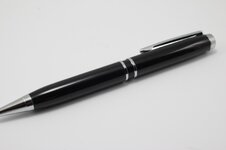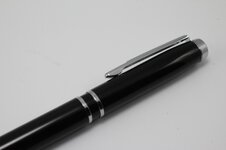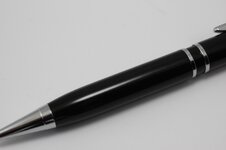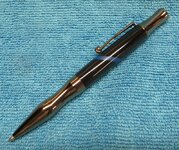mikeschn
Member
Okay so mredburn suggested I post my pen here, to look for helpful suggestions... don't beat me up too badly, I just picked up this hobby in January...
So today when I got home I had two packages waiting for me. One from Ed with blanks, and another from Joe, with pen kits... I was going to wait til tomorrow morning, but being the newbie that I am, I had to try to turn a pen tonight.
So I grabbed the RP Coal Black blank, and the Elegant American 8mm kit, and went downstairs to see what I could do...
Let me tell you, before we even start... turning black is brutal. And sanding black is just as brutal... but mredburn said post good pics.... so here is my attempt at pics... Oh, btw, taking pictures of black is brutal too.
So anyways, I tried to sand all the circular rings out. Every other grit I stopped the lathe and went fore and aft, across the circular rings... I thought I had most of them out, when I took a pic on the lathe. But when I assembled the pen, low and behold, there were rings...
Suggestions?
Mike...
So today when I got home I had two packages waiting for me. One from Ed with blanks, and another from Joe, with pen kits... I was going to wait til tomorrow morning, but being the newbie that I am, I had to try to turn a pen tonight.
So I grabbed the RP Coal Black blank, and the Elegant American 8mm kit, and went downstairs to see what I could do...
Let me tell you, before we even start... turning black is brutal. And sanding black is just as brutal... but mredburn said post good pics.... so here is my attempt at pics... Oh, btw, taking pictures of black is brutal too.
So anyways, I tried to sand all the circular rings out. Every other grit I stopped the lathe and went fore and aft, across the circular rings... I thought I had most of them out, when I took a pic on the lathe. But when I assembled the pen, low and behold, there were rings...
Suggestions?
Mike...







